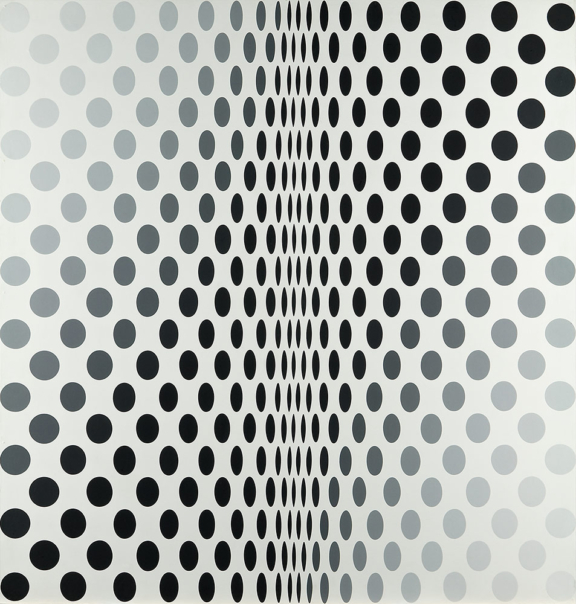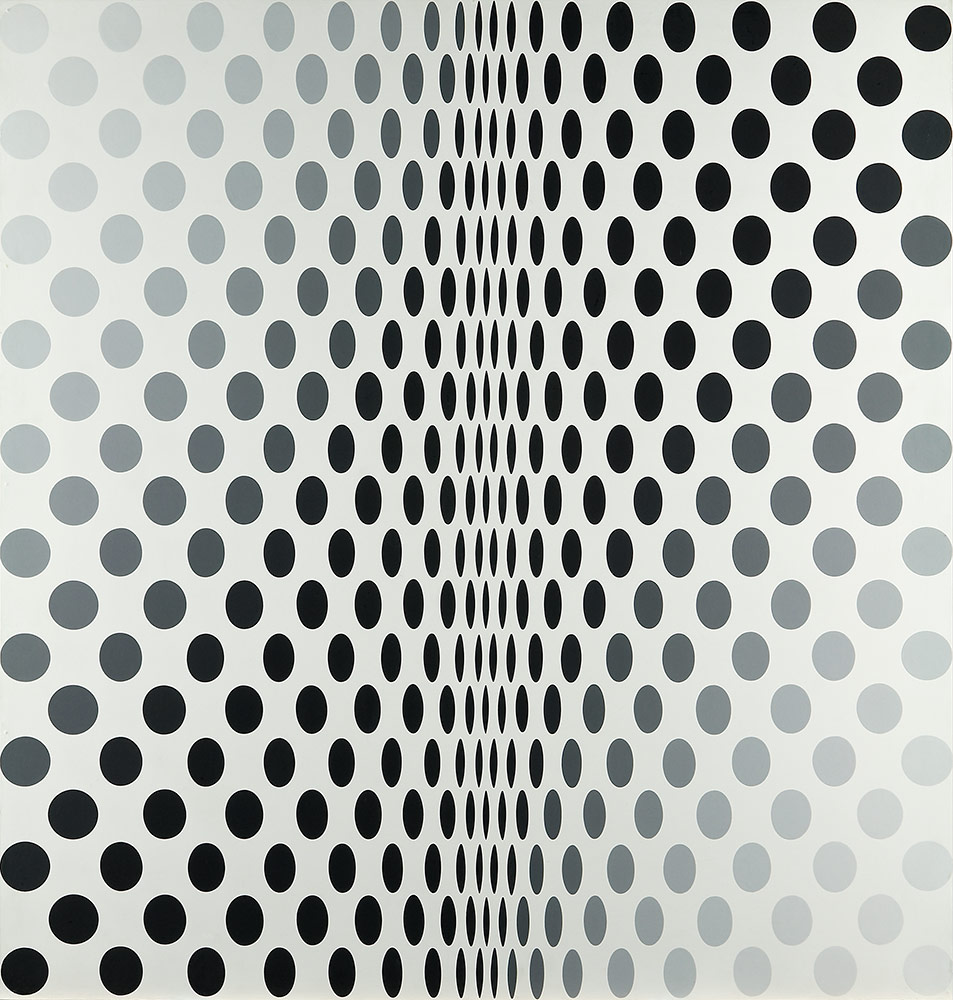
- 1964
- Wood
- Liquid suspension
- Inv. PE158
Bridget Riley
Metamorphosis
Perhaps the most important concept in understanding Bridget Riley’s work is “the consciousness that the equilibrium within a rigid structure could be disturbed and then restored.” In illustrating this idea, linked to the non-rigidity of geometric shapes (a concept that defies common sense), Riley likes to evoke the experience of a heavy rain shower in the summer of 1960, in Venice, when the rain, falling onto the black and white tiled paving, seemed to dissolve the uniformity of the stones, which became sharp again once they had dried.
In Metamorphosis, Riley works on a level of optical ambiguity, generated in the observer by the suggestion of progressive movement and the luminous effects of the grey circles – worked in continuous tonal progression from dark grey to the palest grey –, impeccably outlined on the continuous field of the immaculate white background. In Riley’s painting there is no mathematic element, despite our being faced with a geometric abstraction. We find no direct mark from the hand of the artist, who since 1961 preferred to entrust the execution of her paintings to assistants, reserving for herself the task of preparatory studies for the works and the cutting of shapes used for masking the outlines of her dynamic structures.
Despite coming from a rigid structure, orchestrated to the millimetre – in which the place and function of every element can be determined only in relation to the overall structure –, her work interacts freely with the observer, in a pictorial application of Stravinsky’s phrase: «The more art is controlled, limited, worked over, the more it is free».*
Ana Vasconcelos
May 2010
* In Frances Spalding, «Bridget Riley and the Poetics of Instability », in Bridget Riley. Paintings from the 1960s and 70s, London, Serpentine Gallery, 1999, p. 19.
| Type | Value | Unit |
| Width | 108 | cm |
| Width | 106,7 | cm |
| Height | 112,2 | cm |
| Height | 113 | cm |
| Depth | 3,5 | cm |
| Depth | 3 | cm |
| Type | Acquisition |
| Heimo Zobernig e a Colecção do Centro de Arte Moderna da Fundação Calouste Gulbenkian/ Heimo Zobernig and the Collection of the Calouste Gulbenkian Foundation Modern Art Centre; Heimo Zobernig and the Tate Colllection/ Heimo Zobernig e a Colecção da Tate |
| Lisboa/ St. Ives, 2009 |
| ISBN:978-1-85437-826-2 |
| Catálogo de exposição |
| A Ilha do Tesouro / Treasure Island |
| CAMJAP/FCG |
| Curator: CAMJAP/FCG |
| 7 de Fevereiro de 1997 a 4 de Maio de 1997 Todo o espaço expositivo do CAM - pisos 0, 1 e 01, e Galeria de Exposições Temporárias. |
| Comissários da exposição: Jorge Molder e Rui Sanches. |
| Metamorphosis - British Art of the Sixties: works from the collections of the British Council and the Calouste Gulbenkian Foundation |
| Basil & Elise Goulandris Foundation - Museum of Contemporary Art |
| Curator: Fleurette P. Karadontis |
| 26 de Junho de 2005 a 25 de Setembro de 2005 Basil & Elise Goulandris Foundation - Museum of Contemporary Art |
| Comissários da exposição: Richard Riley, British Council, London, e Ana Vasconcelos e Melo, CAMJAP-FCG, Lisboa. |
| 100 Obras de Arte Britânica Contemporânea |
| Fundação Calouste Gulbenkian |
| Curator: Fundação Calouste Gulbenkian |
Galeria de exposições temporárias, FCG |
| Exposição realizada em Janeiro 1971, na Galeria de exposições temporárias, FCG. |
| Revolução Cinética |
| Museu do Chiado |
| Curator: Emmanuel Guigon |
| 14 de Março de 2008 a 16 de Junho de 2008 Museu do Chiado |
| Exposição comissariada por Emmanuel Guigon.a exposição "centra-se nas preocupações cinéticas que ocuparam um amplo grupo de artistas das vanguardas históricas até à actualidade e que tiveram como resultado um destacado conjunto de experiências que constituem um acontecimento ímpar dentro da história da arte do século XX. A exposição pretende ser uma panorãmica sobre as questões que em cada momento impulsionaram estes artistas para o cinestismo, reunindo os principais autores internacionais e nacionais, como Marcel Duchamp, Victor Vasarely, Yaacov Agam, Pol Bury, Karl Gerstner, Bridget Riley, entre outros. |
| The Gulbenkian Foundation and British Art |
| Tate Britain |
| Curator: Tate Britain |
| 1 e 10 de Março de 2006 a Fevereiro de 2007 Londres, Tate Britain |
| A exposição fez parte das comemorações dos 50 anos da Fundação Calouste Gulbenkian que começaram oficialmente a 18 de Julho de 2006. |
| Heimo Zobernig e a Colecção do Centro de Arte Moderna da Fundação Calouste Gulbenkian |
| CAM/FCG |
| Curator: Jürgen Bock |
| 11 de Fevereiro de 2009 a 31 de Agosto Centro de Arte Moderna |
| Exposição realizada em parceria com a Tate St. Ives. Inclui obras da colecção da Tate de St. Ives, do Centro de Arte Moderna e do artista Heimo Zobernig. De 24 de Maio a 31 de Agosto de 2009 estiveram expostas apenas as obras do CAM escolhidas pelo artista. |
